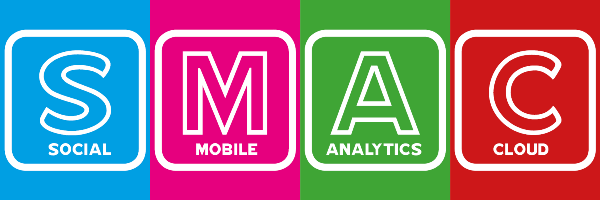SMAC - Social, Mobile, Analytics, Cloud: A Guide
By Team Arrk |
|
4 mins read |

Described as “driving innovation inside many, if not most, enterprises” by Vince Kellen in the Cutter IT Journal, social, mobile, analytics, cloud (SMAC) represents a bundle of new technologies that is rapidly replacing basic messaging and communication services, as well as network infrastructures and ERP.
It brings a new dimension to business models by making organisations more collaborative, connective, productive and real-time than ever before. In this SMAC Guide we take a look at what SMAC is and how it can work for your business.
What is SMAC?
SMAC is something of a buzzword in the IT industry. In the past, all business information was generally kept on a centralised database and accessed via a client server model. This meant that employees would have to log in to a SCM, ERP or CRM system. Prior to that, the employee would usually have to undertake a training programme to help them understand all of the complicated workflows, processes and interfaces.
Today, this has been addressed by the arrival of data visualisation tools and customised ISVs that are built with industry specific templates, improving the user’s experience and allowing executives to quickly gain access to the latest business information. Added to this have been the integration of analytics tools and a host of social and collaborative procedures: all of which can be accessed via mobile devices.
This combination of new technologies is known as Social, Mobile, Analytics and Cloud: or SMAC for short. Social helps people to find their colleagues, who they can then collaborate with; mobile provides access to other data sources and the cloud; the cloud contains the information and the applications that people use; and analytics allows people to make sense of this data. The broad idea of SMAC is that social networks like Facebook and Twitter can be used for brand building and customer engagement; big data analytics can be used to analyse large volumes of data; cloud computing provides a shared pool of resources; and mobile applications provide access to services on the go.
Why SMAC is so important for businesses
In the coming years, it is widely expected that there will be three major trends that emerge and affect not only IT technologies but also the way we do business: all of which will be heavily impacted by SMAC. These include:
- New working styles: Today in business, both employees and customers expect a style of content, collaboration and commerce that offers the same “anytime, anywhere” convenience that they enjoy related to their personal lives with companies such as Facebook and Amazon. It is expected that there will be an increase in the mobile elite workforce; especially as wearable devices such as watches and glasses add to user’s options.In terms of SMAC, business applications will be required to embrace this approach in order to maximise productivity and convenience. It is expected that SMAC architectures will become the new way forward for interaction and the preferred application paradigm. IT departments will need to offer a contextually relevant experience that will support new working styles – seamlessly integrating mobile application management with device management and social platforms.
- Digitisation of processes and business models: With society and nations migrating towards the internet economy, entire business processes are becoming increasingly digitised. Many media and entertainment industries have made the digital switch – such as music and movies – and now it is likely that other industries will see their physical chain become increasingly digitised.In the SMAC era, the role of the CIO will change from an engineer to a pioneer with processes set to be broken down into individual components and redesigned from a digital perspective. Business process analysts will become more like business process scientists needing to combine analytic skills with an understanding of how to make the most of emerging technologies. Hybrid cloud environments will also be needed to support these dynamic services and help create flexible models for these digital services.
- Information overload: According to Cisco, the number of devices that are connected to IP networks will actually be three times higher than the population by 2017. This exponential growth, which will include the emergence of the internet of things, will place new burdens on data centres and existing information infrastructures.As such, within the SMAC area, IT departments will need to supply an infrastructure layer that is capable of dealing with vast amounts of data streaming as well as making informative and intelligent decisions. It has even been predicted by Gartner that 10 per cent of computers will be learning and not processing devices by 2017.
What trends can we expect related to SMAC?
According to NASSCOM, an additional 10 per cent will be spent on IT to deploy mobile solutions before 2020. This mobility market could be worth between $140-150billion on a worldwide basis.
In addition, in-memory databases will be used to speed up analytical processes, which will offer a host of benefits. It will allow analytical processing and transactions to take place within the same in-memory database. Finally, there should be improvements across the voice over internet protocol (VoIP) that will give companies insight into their mobile workforce.
It will be necessary for IT departments to master the deployment and development of SMAC to support the work styles of their customers and employees, to understand how to access new technologies and to address the forthcoming information overload. It will be necessary to focus on intelligent analytics to make informed decisions and ensure smooth processing.
In summary, success will be realised by the organisations that don’t just react to SMAC: but that migrate quickly to it.







